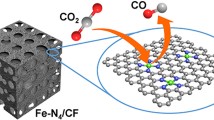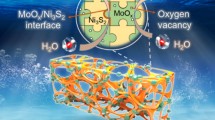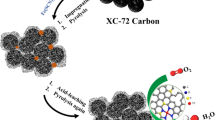Abstract
Oxygen reduction reaction (ORR) is a crucial reaction for various energy conversion and storage devices, but the sluggish kinetics and the usage of noble metals greatly restrict its practical device applications. In this work, a well-designed high-performance catalyst for ORR was synthesized via a facile one-step Co-MOF carbonization method, in which Co-MOF was prepared using the cobalt acetate tetrahydrate and 2,2′-bipyridyl-5,5′-dicarboxylic acid (H2bpydc) as the only raw materials and H2bpydc as the favorable carbon and nitrogen source for in situ nitrogen doping and metallic cobalt reduction. The resultant 3D mesoporous carbon foam catalyst with embedded Co nanoparticles (CoN–CF) is enriched with nitrogen, which exhibits high specific surface area and abundant N-doping active sites for catalytic ORR. In particular, the optimized CoN–CF-700 sample displays the best catalytic performances including onset potential of 0.94 V, half-wave potential of 0.85 V, long-term durability and superior resistance to methanol poisoning. The demonstrated synthetic strategy provides a new insight into easy-synthesis and high-economy routes for metal–N–C catalysts and a deeper understanding of the effects of microstructures on catalytic mechanisms.






Similar content being viewed by others
References
Cao X, Tan C, Sindoro M, Zhang H (2017) Hybrid micro-/nanostructures derived from metal–organic frameworks: preparation and applications in energy storage and conversion. Chem Soc Rev 46:2660–2677
Chu S, Majumdar A (2012) Opportunities and challenges for a sustainable energy future. Nature 488:294
Debe MK (2012) Electrocatalyst approaches and challenges for automotive fuel cells. Nature 486:43
Fan Z, Zhang H (2016) Crystal phase-controlled synthesis, properties and applications of noble metal nanomaterials. Chem Soc Rev 45:63–82
Nie Y, Li L, Wei Z (2015) Recent advancements in Pt and Pt-free catalysts for oxygen reduction reaction. Chem Soc Rev 44:2168–2201
Wu G, More KL, Johnston CM, Zelenay P (2011) High-performance electrocatalysts for oxygen reduction derived from polyaniline, iron, and cobalt. Science 332:443
Song P, Luo M, Liu XZ, Xing W, Xu WL, Jiang Z, Gu L (2017) Zn single atom catalyst for highly efficient oxygen reduction reaction. Adv Funct Mater 27:1700802
Feng Y, Xu C, Hu E, Xia B, Ning J, Zheng C, Zhong Y, Zhang Z, Hu Y (2018) Construction of hierarchical FeP/Ni2P hollow nanospindles for efficient oxygen evolution. J Mater Chem A 6:14103–14111
Sun D, Ye L, Sun F, García H, Li Z (2018) From mixed-metal MOFs to carbon-coated core–shell metal alloy@metal oxide solid solutions: transformation of Co/Ni-MOF-74 to CoxNi1−x@CoyNi1−yO@C for the oxygen evolution reaction. Inorg Chem 56:5203–5209
Wang X, Yu L, Bu Y, Song S, Lou XW (2018) Metal–organic framework hybrid-assisted formation of Co3O4/Co–Fe oxide double-shelled nanoboxes for enhanced oxygen evolution. Adv Mater 30:1801211
Hu E, Feng Y, Nai J, Zhao D, Hu Y, Lou XW (2018) Construction of hierarchical Ni–Co–P hollow nanobricks with oriented nanosheets for efficient overall water splitting. Energy Environ Sci 11:872–880
Hu E, Ning J, Zhao D, Xu C, Lin Y, Zhong Y, Zhang Z, Wang Y, Hu Y (2018) A room-temperature postsynthetic ligand exchange strategy to construct mesoporous Fe-doped CoP hollow triangle plate arrays for efficient electrocatalytic water splitting. Small 14:1704233
Jiao Y, Zheng Y, Jaroniec M, Qiao SZ (2015) Design of electrocatalysts for oxygen- and hydrogen-involving energy conversion reactions. Chem Soc Rev 44:2060–2086
Zhang W, Wu ZY, Jiang HL, Yu SH (2014) Nanowire-directed templating synthesis of metal–organic framework nanofibers and their derived porous doped carbon nanofibers for enhanced electrocatalysis. J Am Chem Soc 136:14385–14388
Yang HB, Miao J, Hung SF, Chen J, Tao HB, Wang X, Zhang L, Chen R, Gao J, Chen HM, Dai L, Liu B (2016) Identification of catalytic sites for oxygen reduction and oxygen evolution in N-doped graphene materials: development of highly efficient metal-free bifunctional electrocatalyst. Sci Adv 2:e1501122
Ren Q, Wang H, Lu X, Tong Y, Li G (2018) Recent progress on MOF-derived heteroatom-doped carbon-based electrocatalysts for oxygen reduction reaction. Adv Sci 5:1700515
Wang Y, Chen W, Chen Y, Wei B, Chen L, Peng L, Xiang R, Li J, Wang Z, Wei Z (2018) Carbon-based catalysts by structural manipulation with iron for oxygen reduction reaction. J Mater Chem A 6:8405–8412
Bu Y, Lu Y, Wang Y, Wu M, Lou XW (2018) Porous iron–cobalt alloy/nitrogen-doped carbon cages synthesized via pyrolysis of complex metal–organic framework hybrids for oxygen reduction. Adv Funct Mater 28:1706738
Hu E, Yu X, Chen F, Wu Y, Hu Y, Lou XW (2018) Graphene layers-wrapped Fe/Fe5C2 nanoparticles supported on N-doped graphene nanosheets for highly efficient oxygen reduction. Adv Energy Mater 8:1702476
Li M, Bai L, Wu S, Wen X, Guan J (2018) Co/CoOx nanoparticles embedded on carbon for efficient catalysis of oxygen evolution and oxygen reduction reactions. Chem Sus Chem 11:1722–1727
Li S, Cheng C, Liang H, Feng X, Thomas A (2017) 2D porous carbons prepared from layered organic–inorganic hybrids and their use as oxygen-reduction electrocatalysts. Adv Mater 29:1700707
Fu X, Zamani P, Chio J, Hassan F, Jiang F, Higgins D, Zhang Y, Hoque M, Chen Z (2017) In situ polymer graphenization ingrained with nanoporosity in a nitrogenous electrocatalyst boosting the performance of polymer-electrolyte-membrane fuel cells. Adv Mater 29:1604456
Zhan T, Lu S, Rong H, Hou W, Teng H, Wen Y (2018) Metal–organic-framework-derived Co/nitrogen-doped porous carbon composite as an effective oxygen reduction electrocatalyst. J Mater Sci 53:6774–6784. https://doi.org/10.1007/s10853-018-1989-x
Kim H, Kim Y, Noh Y, Lee S, Sung J, Kim WB (2017) Thermally-converted CoO nanoparticles embedded into N-doped carbons as highly efficient bi-functional electrocatalysts for oxygen reduction and evolution reactions. Chem Cat Chem 9:1503–1510
Hou Y, Wen Z, Cui S, Ci S, Shun Mao, Chen J (2015) An advanced nitrogen-doped graphene/cobalt-embedded porous carbon polyhedron hybrid for efficient catalysis of oxygen reduction and water splitting. Adv Funct Mater 25:872–882
Tang H, Zeng Y, Zeng Y, Wang R, Cai S, Liao C, Cai H, Lu X, Tsiakaras P (2017) Iron-embedded nitrogen doped carbon frameworks as robust catalyst for oxygen reduction reaction in microbial fuel cells. Appl Catal B Environ 202:550–556
Zhang Y, Ge J, Wang L, Wang D, Ding F, Tao X, Chen W (2013) Manageable N-doped graphene for high performance oxygen reduction reaction. Sci Rep 3:2771
Chen Y, Wang C, Wu Z, Xiong Q, Xu Q, Yu SH, Jiang HL (2015) From bimetallic metal–organic framework to porous carbon: high surface area and multicomponent active dopants for excellent electrocatalysis. Adv Mater 27:5010–5016
Xia B, Yan Y, Li N, Wu HB, Lou XW, Wang X (2016) A metal–organic framework-derived bifunctional oxygen electrocatalyst. Nat Energy 1:15006
Huang Y, Liang J, Wang X, Cao R (2017) Multifunctional metal–organic framework catalysts: synergistic catalysis and tandem reactions. Chem Soc Rev 46:126–157
Kaneti Y, Tang J, Salunkhe R, Jiang X, Yu A, Wu K, Yamauchi Y (2017) Nanoarchitectured design of porous materials and nanocomposites from metal–organic frameworks. Adv Mater 29:1604898
Zhu L, Liu XQ, Jiang HL, Sun LB (2017) Metal–organic frameworks for heterogeneous basic catalysis. Chem Rev 117:8129–8176
Xu J, Lawson T, Fan H, Su D, Wang G (2018) Updated metal compounds (MOFs, S, OH, N, C) used as cathode materials for lithium–sulfur batteries. Adv Energy Mater 8:1702607
Kitao T, Zhang Y, Kitagawa S, Wang B, Uemura T (2017) Hybridization of MOFs and polymers. Chem Soc Rev 46:3108–3133
Furukawa H, Cordova KE, O’Keeffe M, Yaghi OM (2013) The chemistry and applications of metal–organic frameworks. Science 341:1230444
Fang X, Jiao L, Yu SH, Jiang HL (2017) Metal–organic framework-derived FeCo–N-doped hollow porous carbon nanocubes for electrocatalysis in acidic and alkaline media. Chem Sus Chem 10:3019–3024
Li X, Jiang Q, Dou S, Deng L, Huo J, Wang S (2016) ZIF-67-derived Co–NC@CoP–NC nanopolyhedra as an efficient bifunctional oxygen electrocatalyst. J Mater Chem A 4:15836–15840
Hu H, Han L, Yu M, Wang Z, Lou XW (2016) Metal–organic-framework-engaged formation of Co nanoparticle-embedded carbon@Co9S8 double-shelled nanocages for efficient oxygen reduction. Energy Environ Sci 9:107–111
Wang J, Jing X, Cao Y, Li G, Huo Q, Liu Y (2015) Structural diversity and magnetic properties of three metal–organic frameworks assembled from a T-shaped linker. Cryst Eng Commun 17:604–611
Liu Y, Hu Y, Zhou M, Qian H, Hu X (2012) Microwave-assisted non-aqueous route to deposit well-dispersed ZnO nanocrystals on reduced graphene oxide sheets with improved photoactivity for the decolorization of dyes under visible light. Appl Catal B Environ 125:425–431
Hu W, Wang Q, Wu S, Huang Y (2016) Facile one-pot synthesis of a nitrogen-doped mesoporous carbon architecture with cobalt oxides encapsulated in graphitic layers as a robust bicatalyst for oxygen reduction and evolution reactions. J Mater Chem A 4:16920–16927
Jiang H, Liu Y, Li W, Li J (2018) Co nanoparticles confined in 3D nitrogen-doped porous carbon foams as bifunctional electrocatalysts for long-life rechargeable Zn–air batteries. Small 14:1703739
Guo C, Liao W, Li Z, Chen C (2015) Exploration of the catalytically active site structures of animal biomass-modified on cheap carbon nanospheres for oxygen reduction reaction with high activity, stability and methanol-tolerant performance in alkaline medium. Carbon 85:279–288
Wu Z, Xu X, Hu B, Liang H, Lin Y, Chen L, Yu SH (2015) Iron carbide nanoparticles encapsulated in mesoporous Fe–N-doped carbon nanofibers for efficient electrocatalysis. Angew Chem Int Ed 127:8297–8301
Guo C, Hu R, Liao W, Li Z, Sun L, Shi D, Li Y, Chen C (2017) Protein-enriched fish “biowaste” converted to three-dimensional porous carbon nano-network for advanced oxygen reduction electrocatalysis. Electrochim Acta 236:228–238
Yoon KR, Choi J, Cho SH, Jung JW, Kim C, Cheong JY, Kim ID (2018) Facile preparation of efficient electrocatalysts for oxygen reduction reaction: one-dimensional meso/macroporous cobalt and nitrogen Co-doped carbon nanofibers. J Power Sources 380:174–184
Tan AD, Wan K, Wang YF, Fu ZY, Liang ZX (2018) N, S-containing MOF-derived dual-doped mesoporous carbon as a highly effective oxygen reduction reaction electrocatalyst. Catal Sci Technol 8:335–343
Liu Y, Jiang H, Zhu Y, Yang X, Li C (2016) Transition metals (Fe Co, and Ni) encapsulated in nitrogen-doped carbon nanotubes as bi-functional catalysts for oxygen electrode reactions. J Mater Chem A 4:1694–1701
Zhang E, Xie Y, Ci S, Jia J, Cai P, Yi L, Wen Z (2016) Multifunctional high-activity and robust electrocatalyst derived from metal–organic frameworks. J Mater Chem A 4:17288–17298
Yang W, Liu X, Chen L, Liang L, Jia J (2017) A metal–organic framework devised Co–N doped carbon microsphere/nanofiber hybrid as a free-standing 3D oxygen catalyst. Chem Commun 53:4034–4037
Chen Y, Guo Y, Cui H, Xie Z, Zhang X, Wei J, Zhou Z (2018) Bifunctional electrocatalysts of MOF-derived Co–N/C on bamboo-like MnO nanowires for high-performance liquid- and solid-state Zn–air batteries. J Mater Chem A 6:9716–9722
Guan B, Yu L, Lou XW (2017) Formation of single-holed cobalt/N-doped carbon hollow particles with enhanced electrocatalytic activity toward oxygen reduction reaction in alkaline media. Adv Sci 4:1700247
You B, Jiang N, Sheng M, Drisdell WS, Yano J, Sun Y (2015) Bimetal–organic framework self-adjusted synthesis of support-free nonprecious electrocatalysts for efficient oxygen reduction. ACS Catal 5:7068–7076
Li Z, Zhao D, Xu C, Ning J, Zhong Y, Zhang Z, Wang Y, Hu Y (2018) Reduced CoNi2S4 nanosheets with enhanced conductivity for high-performance supercapacitors. Electrochim Acta 278:33–41
Hu E, Ning J, He B, Li Z, Zheng C, Zhong Y, Zhang Z, Hu Y (2017) Unusual formation of tetragonal microstructures from nitrogen-doped carbon nanocapsules with cobalt nanocores as a bi-functional oxygen electrocatalyst. J Mater Chem A 5:2271–2279
Huang L, Zhang X, Han Y, Wang Q, Fang Y, Dong S (2017) In situ synthesis of ultrathin metal–organic framework nanosheets: a new method for 2D metal-based nanoporous carbon electrocatalysts. J Mater Chem A 5:18610–18617
Liang HW, Zhuang X, Brüller S, Feng X, Müllen K (2014) Hierarchically porous carbons with optimized nitrogen doping as highly active electrocatalysts for oxygen reduction. Nat Commun 5:4973
Deng D, Pan X, Yu L, Cui Y, Jiang Y, Qi J, Li WX, Fu Q, Ma X, Xue Q, Sun G, Bao X (2011) Toward N-doped graphene via solvothermal synthesis. Chem Mater 23:1188–1193
Guo C, Li Y, Liao W, Liu Y, Li Z, Sun L, Chen C, Zhang J, Si Y, Li L (2018) Boosting the oxygen reduction activity of a three-dimensional network Co–N–C electrocatalyst via space-confined control of nitrogen-doping efficiency and the molecular-level coordination effect. J Mater Chem A 6:13050–13061
Nandan R, Nanda KK (2017) Designing N-doped carbon nanotubes and Fe–Fe3C nanostructures Co-embedded in B-doped mesoporous carbon as an enduring cathode electrocatalyst for metal–air batteries. J Mater Chem A 5:16843–16853
Lai L, Potts JR, Zhan D, Wang L, Poh C, Tang C, Gong H, Shen Z, Lin J, Ruoff R (2012) Exploration of the active center structure of nitrogen-doped graphene-based catalysts for oxygen reduction reaction. Energy Environ Sci 5:7936–7942
Hu F, Yang H, Wang C, Zhang Y, Lu H, Wang Q (2017) Co–N-doped mesoporous carbon hollow spheres as highly efficient electrocatalysts for oxygen reduction reaction. Small 13:1602507
Acknowledgements
Y. Hu acknowledges the financial support from Natural Science Foundation of China (21671173). J. Q. Ning acknowledges the financial support from Natural Science Foundation of China (11874390), Cutting-edge Key Research Program of Chinese Academy of Sciences (QYZDB-SSW-JSC014) and Hundred Talents Program of Chinese Academy of Sciences.
Author information
Authors and Affiliations
Corresponding authors
Electronic supplementary material
Below is the link to the electronic supplementary material.
Rights and permissions
About this article
Cite this article
Xu, C., Lin, Z., Zhao, D. et al. Facile in situ fabrication of Co nanoparticles embedded in 3D N-enriched mesoporous carbon foam electrocatalyst with enhanced activity and stability toward oxygen reduction reaction. J Mater Sci 54, 5412–5423 (2019). https://doi.org/10.1007/s10853-018-03255-0
Received:
Accepted:
Published:
Issue Date:
DOI: https://doi.org/10.1007/s10853-018-03255-0




